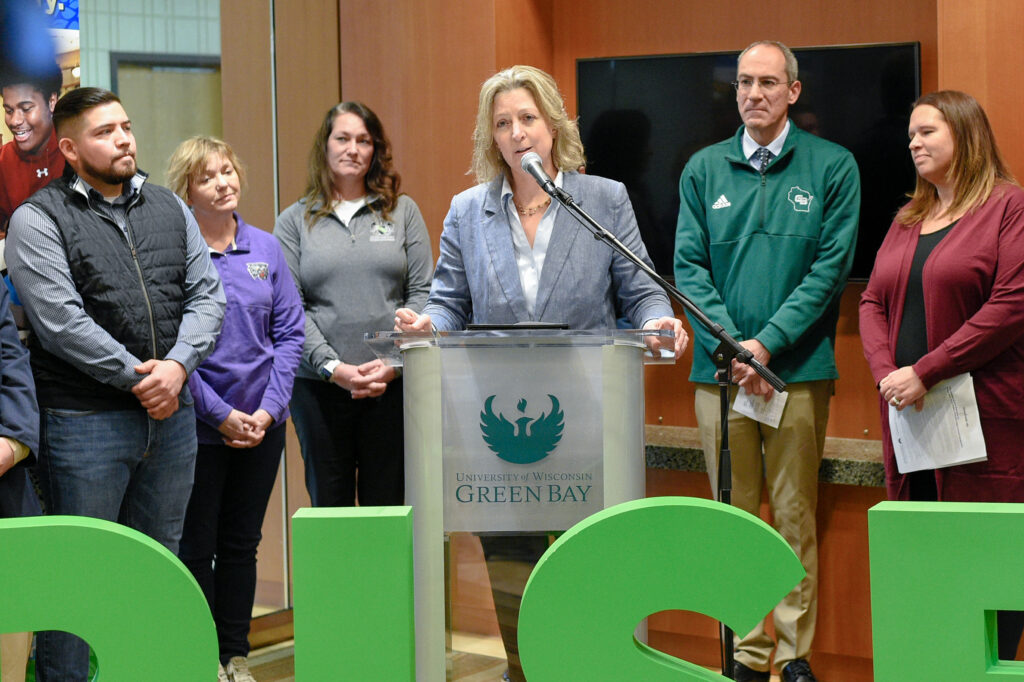
By William Kopp
Contributing Writer
GREEN BAY – On Feb. 13, the University of Wisconsin-Green Bay held a news conference to announce a first-in-the-state Direct Admit partnership with Green Bay Area Public Schools.
“The first-in-the-state collaboration will be available to all class of 2024 students in Green Bay Area Public Schools,” a Feb. 10 press release stated. “The program removes the barrier of admission and instead invites a conversation with students and their families about the options available for further learning after receiving a high school diploma.”
UW-Green Bay Chancellor Michael Alexander opened up the ceremony, speaking on the importance of this step and what that meant moving forward for UW-Green Bay and Green Bay as a whole.
“About five years ago, UW-Green Bay changed its mission,” he stated. “At that time it determined it was going to become an access institution. And when we made that change we began realigning the university immediately behind what that means.”
The meaning behind an access institution is certainly a new concept for many, but it represents a new concept to build on for future generations of university students.
Alexander continued, “An access institution believes that it is the goal of the university to make sure that people who want education can get [education].”
“UW-Green Bay’s direct admissions initiative removes the application process that — for some students — may feel like an overwhelming barrier to overcome in order to pursue any type of higher education dream, especially for students who may be the first in their families to graduate from a high school,” said Vicki Bayer, superintendent for Green Bay schools.
Most universities search out students with the highest GPAs, with the most promising futures coming straight out of high school, but that’s not what access institutions are about.
They search to give everyone a fair chance, and as Alexander put, “[To us] education is a lifelong pursuit, it’s something that you don’t stop when you graduate high school. The average student age at UW-Green Bay is around 24 years old.”
The goal for them is to bring in new students, no matter the age, and offer opportunities that other schools wouldn’t due to GPA, among other things.
UW-Green Bay has already offered 31 local students direct admin access, and 21 have committed to attending the college while 10 have pursued other institutions for higher education.
“We are not, as a direct admission, trying to influence a student choosing between us and another university,” Alexander said. “They’re [going to] choose us based on our merit and [select] the fit that is right for them. What we know is there are a ton of students who need a local solution. They have family reasons, they have economic reasons or they’re actively contributing to the workforce of northeast Wisconsin. And rather than fight that, we need to make sure we have great local options.”
With colleges like St. Norbert College, Northeast Wisconsin Technical College (NWTC) and UW-Green Bay all working to solve the issue, northeast Wisconsin is steadily moving toward an education focused on potential and accessibility, not prestige and past achievements.
“By working together we not only improve the lives of our students at Green Bay Area Public School District (GBAPSD) and their families, but we strengthen the community,” Bayer stated.
Alexander added, “To us this is really the beginning of what it means to be an institution that is really about access.”
Through the elimination of the application process, the barrier of an application is removed and instead invites anyone — regardless of age, GPA or current career path — to pursue a higher education.
Current high school juniors can begin preparing for enrollment now by doing well in their current studies, and families can prepare by utilizing the direct admin team to help answer questions throughout the enrollment process.
